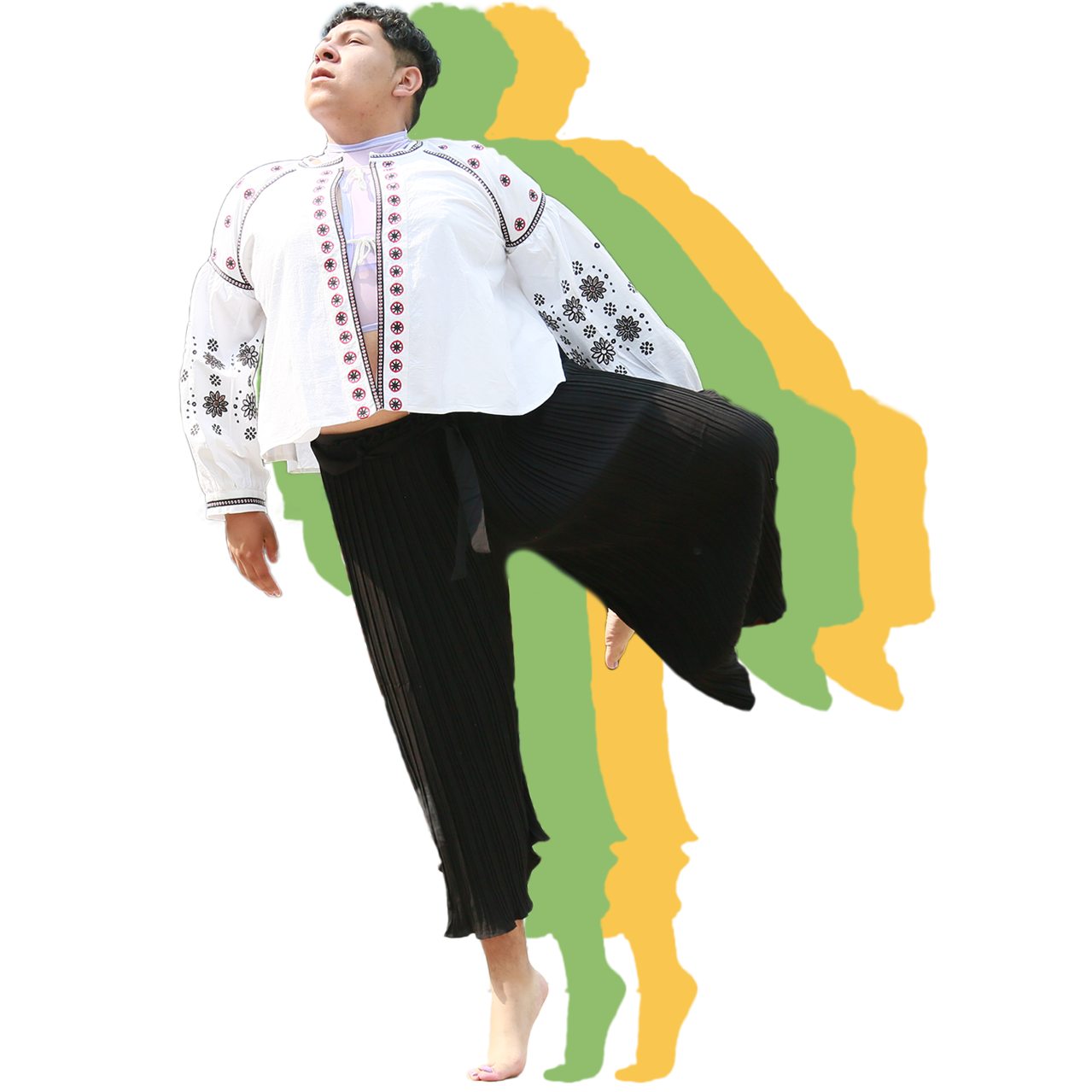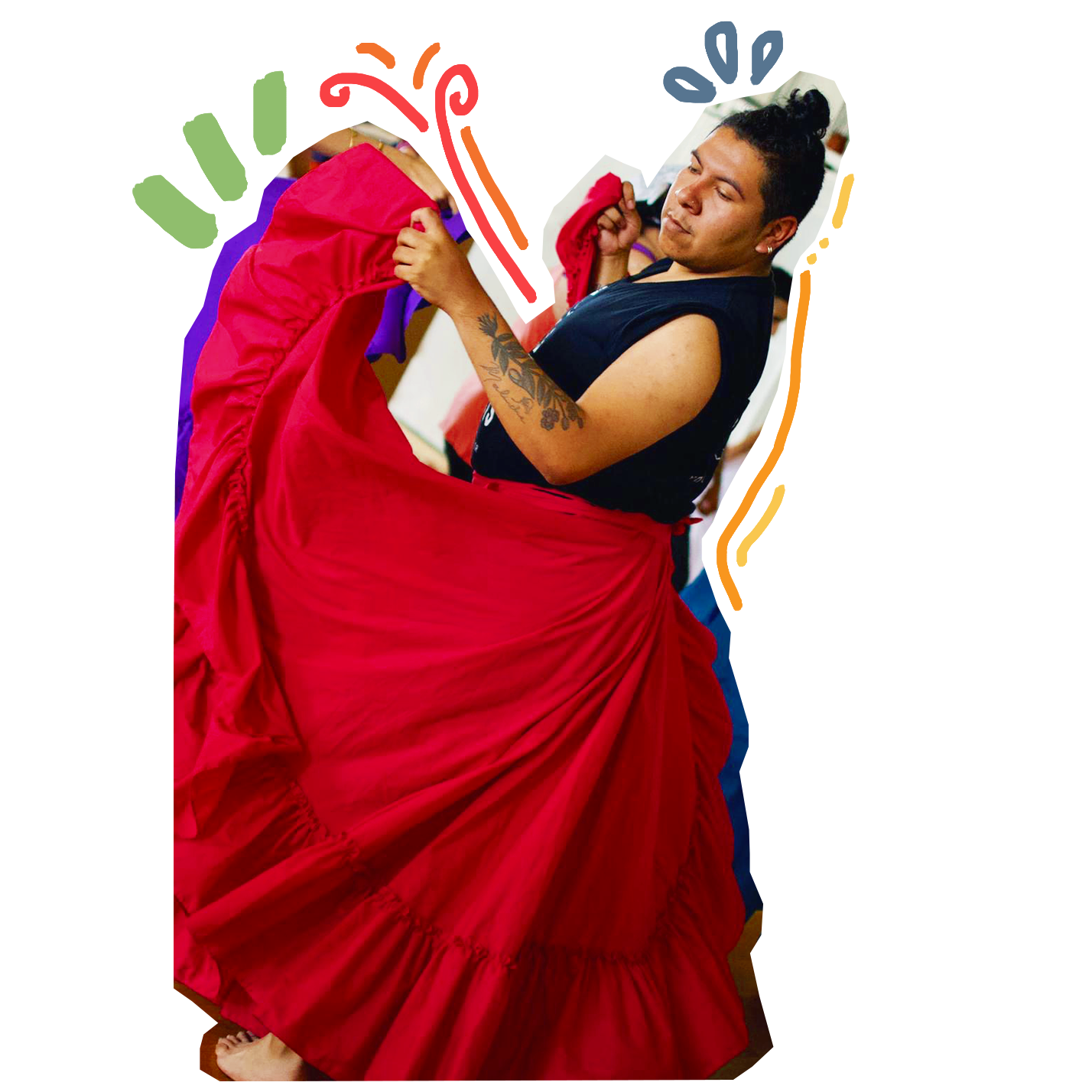A pride for their hood

Dancer, poet, activist y su tía de South Central, Jose Richard Aviles, 29, holds many roles, but working toward bettering their community and using their art to serve as an act of healing and justice for their people has been, and will always be, their priority.
Growing up in South Central, Aviles took to social justice work at a considerably young age. Whether it was working alongside the Labor Community Strategy Center’s Bus Riders Union or joining efforts for marriage equality, 15-year-old Aviles was out in the streets, doing their part — even if that meant receiving possible backlash from their parents.
“I come from parents who come with this nightmare and bullshit that I call the American Dream … so they wanted me to be financially secure,” Aviles said. “How many times have you heard the comment ‘¿Para qué vine a este país? ¿Para que estuvieras en las calles allí protestando? Why did I come to this country so you’d be out there protesting?’ And I’d be like, ‘Mom! But they’re taking our rights away!’ That’s just who I’ve always been.”
Now, they are also using their passion for the arts to further engage with their community. Aviles is never as joyous as they are when they are dancing, and through community dance collectives and their own weekly dedicated time to moving their body, they strive to promote cultural education, respect and healing.
South Central is the birthplace of their love for dance and movement, they said.
“I’m born and raised in South Central and like yo, I learned how to dance before I learned how to walk,” Aviles said. “I was [always] at a quinceñera, at a bautizo, at a birthday party dancing with my cousins and dancing with my tías. It’s the thing that just gives me the most joy.”
Because they didn’t have considerable access to arts institutions and resources growing up, Aviles said they made sure to take advantage of what was made available to them during their undergraduate and graduate experiences in Minnesota and at USC, respectively. After starting college with the intent of studying social work, Aviles ultimately decided to major in dance and focus on enjoying their time before attending graduate school, they said.
However, after getting their undergraduate degree from St. Olaf College in Minnesota, Aviles took their time figuring out what they really wanted. After taking three years off — splitting time between their post-college fantasy trope of New York City, farm-ridden Wisconsin and their forever home in South Central — Aviles finally felt that graduate school was the next step in their journey.
At USC, they pursued a dual masters program in social work and urban planning over three years and graduated in Spring 2019. Aviles was also able to find a space where dancing could be a prominent part of their graduate school experience through the Break On 2 salsa team, for which they served as captain and teaching artist for two years.
Now, as both an alum and someone native to the local community in South Central, Aviles said they feel as though they have a special role to hold the University responsible for its engagement with the surrounding neighborhoods.
“I am committed to this community, not to the University,” Aviles said. “I’ve always been committed to people and not institutions, but I also understand that this institution is a big stakeholder because it has capital power … My job as someone who is an alum and is a community member is to call them out and hold them accountable and to leverage resources for [the] community.”
Dancing keeps Aviles grounded. The salsa team allowed them to pinpoint time each week to move their body and feel joy, and Aviles knew they always needed to create space in their life for dance.
“I don’t know how to explain it, it’s what gives me life,” Aviles said. “I remember coming back from that social dancing and being like … ‘What was I feeling before this?’ … Being in this constant state of euphoria and not having experienced that before, I was like, ‘You know what? I never want to go back to not feeling this feeling, so let me create opportunities for myself to always dance and always feel.’”
Every Monday, followers of Aviles’s Instagram @soynalgona are graced with a new video tagged with the hashtag #MondayDeMovimiento — their way of making sure that feeling of euphoria is never lost. Especially now with safer-at-home orders in place, Aviles has made sure to keep their body moving and joyous.
“During this time, it was really helpful because it was my way of reminding myself that my spirit was still good,” Aviles said. “I tell my friends the moment you ask me to go dancing and I say no, check in on me, something’s wrong.”
In addition to their Instagram dances, Aviles is also a member of the Dancing Diaspora Collective, an L.A.-based dance organization dedicated to honoring and sharing dance practices of the Latin and African diasporas. Patricia Huerta, a fellow Collective member, recently co-choreographed a piece with Aviles that was performed and prerecorded for a coming show at the Ford Amphitheatre — a dream come true for any South Central kid, according to Aviles.
“We do a lot of collaborations, we are still performing together,” Huerta said. “[They] just bring a lot of knowledge to the table, to the group, and [their] expertise in creating content and really honing in with community — that’s extremely valuable, and we value that in our collective.”
Through the Dancing Diaspora Collective, Aviles and Huerta are also able to make sure that dancers and choreographers understand the history behind the pieces and styles they bring to the stage.
“There’s so much. It’s not just about the dancing,” Huerta said. “I think that it’s just so important to know, so that we can really honor the dances that are being presented and know the reason why we have the dances now and all the fusions that we have now.”
Aviles said it’s essential to understand the connectivity between what is considered Latin dance and the reality of its origins.
“All of our music from Latin social dance comes to us through the African diaspora,” Aviles said. “Salsa, merengue, bachata, cumbia, punta, chota … All of these rhythms come to us through the African diaspora.”
The disconnect in this historical understanding is what Aviles considers to be just one example of the anti-Blackness that exists prominently within Latinx culture. The community has not addressed it’s inherent colorism, which demonizes a proximity to Blackness and ignores its roots, Aviles said.
“Being morena and being indígina, you have your Afrodescendientes in every country,” they said. “¿Y si dice que no? Baby you’re in denial and you’re starting to sound like a white supremacist. I am no longer here for that. I am not here anymore for brownness and Latinxness that is like ‘What about us? We need a piece of the pie.’”
In another effort to encourage such dialogue about the cultural history and origins behind dance, Aviles has worked with Conga Kids, a nonprofit organization that typically offered dance classes and programming for fifth and sixth graders in L.A. County. Due to the coronavirus pandemic, Conga Kids is now creating a multi-episode series that serves as a journey through the African diaspora and its many dance styles, in which Aviles recently instructed a digital dance video on Roomba.
Conga Kids executive director Natalie Marrero agrees with Aviles that educating students on the African diaspora and histories of oppression and appropriation is necessary, regardless of age, and said that Aviles’ role is integral in helping young people develop a rich understanding of dance’s origins and purpose.
“Students are not being given proper education about oppression,” Marrero said. “I think knowing someone who can be really clear and articulate about that — even in an underlying way, even if it’s certain kinds of language used and the inclusivity in the language — that is something I aim for. Therefore [so does] this program I’m creating for young people that are impressionable. They deserve a gateway, even if it’s just uncovering the dust so that they can dive and dive deeper.”
Aviles’ art expression is not encapsulated only through dance, but is also expressed through their writing. What started out as a singular semilla poem, has now turned into “Semilla,” Aviles’ first published collection of poetry that serves as a “reflection of the seeds I’ve planted throughout my life and their outcomes.”
While Aviles said the process of writing and compiling this collection was not an easy feat, especially considering the many other roles they simultaneously juggle, they said that the support they have already received for the book makes it all worthwhile.
“At one point, you just learn to let go of our art because you just hope that one person will feel the work that you’re saying,” Aviles said. “These little things, the joy that I get from these conversations, from the random message, from the ‘thank you so much’ — that will always outweigh the arduous work that goes behind it.”
There is no doubt that Aviles has accomplished a lot in their almost 30 years, but above all, coming back home is what they are most proud of.

“Coming from South Central, we’re told all the time, or at least I was, that success is leaving the hood,” Aviles said. “And I just remember thinking to myself, well what about the people who stay behind? … It’s a reminder that I don’t need to be afraid of my hood the way I’ve been conditioned to think. Even as a femme body, even as a brown body, I choose to not be afraid, and I continue to stay here, and I’m going to continue to live here for as long as I can … These are the streets that brought me up and I always need to be committed to the streets.”
Listen to Rhythm and News’ special episode on Jose Richard Aviles here.

